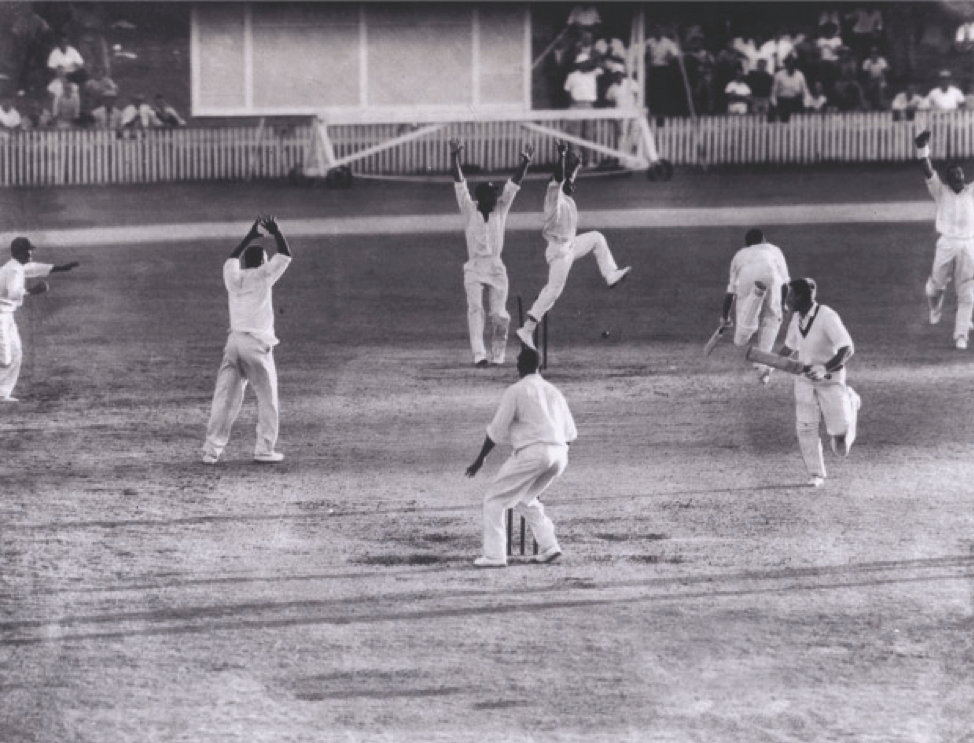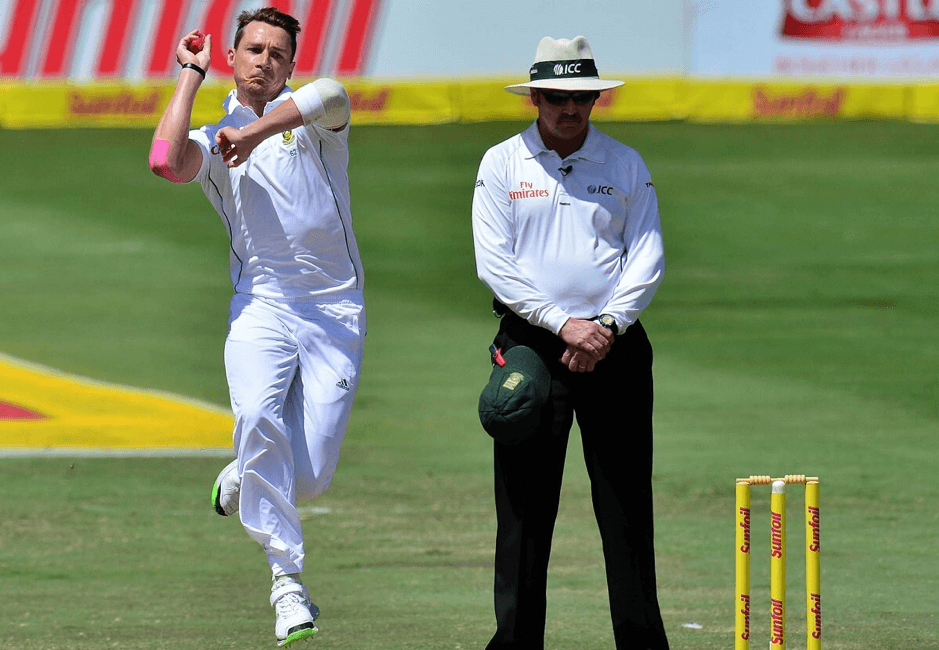THE MATCH THAT SAVED TEST CRICKET
THROWBACKS
KUSHAGR DIXIT | 16th September 2019

1960’s tied test transformed Test cricket forever (Photo by Ron Levitt, The Age newspaper)
“They came as underdogs but left as the most popular sporting team to ever visit Australia” – Michael Habib These immortal words by Michael Habib in the documentary ‘Calypso Summer: 1960-61 Australia vs West Indies Test Cricket Series’ could not have been more apt. Just to clarify, this was an Australia which still had the racial White Australia policy in force wherein even the native Australians weren’t given citizenship by their government. Almost 60 years removed from the series, one can only wonder how this magnificent team must have played to capture the minds and hearts of the Australian public, so much so that the fifth Test match played at the Melbourne Cricket Ground (MCG) set the-then world record for attendance (still a record for any cricket match outside India) at 90,800 spectators. As the great Sir Donald Bradman remarked “That summer which was the best thing to happen to test match cricket.” The 1950s have often been called as the ‘sleepy age of test cricket’ and was symbolized by the snail-paced run rates, drab draws and regularly falling attendances at Test matches. The once jam-packed full houses during the 1930s and 40s were replaced by an apathetic public deriving little to no pleasure from the game putting its very own future at risk. The 1958-59 Ashes were the tipping point for a lot of people with the English only scoring 109 runs on the first day of the inaugural Test in Brisbane. The authorities feared that the paying public would simply refuse to turn up for games and were desperate for a ray of hope. That spark was given to them by the West Indian team led by its first ever black captain, Sir Frank Worrell which included the likes of Sir Garfield Sobers, Wes Hall and Rohan Kanhai. Just like the Aussies, the Caribbean team was famed for its attacking cricket and the entire world hoped to see the two teams showing great intent to go for the win. The series could not have had a better start with the first Test at the Gabba in Brisbane. Upon winning the toss, Worrell chose to bat but found his team teetering at 65-3 with all the three wickets having been taken by Alan Davidson. Sir Frank Worrell came to the crease and put up a fabulous 174-run partnership with a dashing 24-year-old, Gary Sobers. Sobers in that era of dawdling batsmanship took the Australian bowling apart and scored 132 runs in just 174 minutes. By the time Sobers departed the score was 239, but what was even more astonishing was that the West Indies ended the first day at 359/7; a whole 250 runs more than the English had managed just two years back. The morning session on Day 2 belonged to the fearsome fast bowler Wes Hall who scored 50 runs in just 65 minutes. The West Indies finished their innings at 453 with the brilliant all-rounder, Alan Davidson picking up 5/130. The Australian response was gritty to say the least with Wesley Hall bowling well in excess of 90 mph and battering opener Colin McDonald with his lethal deliveries. McDonald who scored an admirable 57 fell to the ground thrice and took hits left, right and center in of the gutsiest innings by an Australian as the home side ended day two at 196/3.
 Day 3 belonged to Norm O’Neill who scored a career best, 181 and that too against arguably the best fast bowler of his time in Hall. His was an innings later described by many lucky enough to witness as some of the best batsmanship since the great Don Bradman himself. Australia scored a mammoth score of 505 in their first innings and the West Indies were at 0/0 at the end of the day’s play. Day 4 began with a solid response by the West Indians who were at 210/4 at one stage, but collapsed to 259/9 and then 284 all out. As many as four batsmen made 39 runs or more but none could go on to a big score. As it turned out, the last pair of the visitors spent quite some time on the crease and left the hosts with a target of 233 to chase in 69 eight-ball overs. Now this asking rate wasn’t out of the ordinary and the Australian camp was targeting a famous victory as their captain Richie Benaud would later state but they made a horrible start and were soon reduced to 92/6 with all hopes seemingly dashed. This was the stage at which the most effective player of the match stamped his authority with his captain at the other end; Alan Davidson is an oft forgotten figure in world sport, but on that barmy Queensland summer afternoon, he matched Benaud stroke for stroke and slowly but surely took Australia back into a commanding position. These two fine players showcased the art of quick cheeky singles to the world for the very first time as they raced against time to get to the target. “Not for a single moment did we want anything but a win”, Benaud would later remark. Rejoining the match in its last few overs, Davidson and Benaud had taken the hosts to 226/6 just 7 runs short of one of the most memorable victories on Australian soil but destiny had something else in store for those 22 men involved in this epic match. With time running out and the batsmen becoming fidgety, Benaud called Davidson for a single which was never there and to his extreme misfortune, the ball went to the one fielder he would’ve loved to have avoided the most, Joe Solomon. Solomon as a young boy was famous in his town for bringing down mangoes with the tiniest of pebbles and he visibly hadn’t lost any of his skill. Such was his precision that standing at square leg with all but one stump to aim at, he caught Davidson short of his crease. What happened in the last over of the Gabba Test of 1960-61 has gone down in the annals of cricketing folklore as some of the most enthralling moments test cricket has ever produced. The first ball hit Wally Grout in his groin and he had to scamper to a single to give the strike to his skipper. This was the start of something special as in the very next ball, Benaud was caught behind of a bouncer by Wesley Hall with the scoreboard now reading 228/8. The third ball was a dot and on the fourth ball, Hall missed the simplest of run outs from just over 3 yards, allowing the batsmen to steal another single. The equation now stood at 4 runs from 4 balls and the next ball was sliced up in the air by Grout but in his eagerness to catch it, Hall almost took Kanhai out with his arm which resulted in a dropped catch. Down to 3 from 3, Ian Meckiff swung his bat and hit the ball hard to deep square leg, as luck would have it the groundsman hadn’t cut the grass on Day 5 in that area and the ball stopped a mere 9 inches from the boundary. Sir Conrad Hunte caught Grout 2 feet short of his crease and the score was a tantalizing 232/9. The task was simple: get a run and win. But often, it’s the simplest things in life that trick one up the most. Lindsay Kline, the No.11 tucked the ball of his pads and ran for a single and as luck would have it another Australian was caught in the Joe Solomon headwinds as he repeated his trick from the previous over and again nailed the only stump visible to him from square leg thus, bringing an end to a match which though had no winners, had one victor which was the gentlemen’s game itself. It was the match everyone had craved for, two fearless teams who fought to the very end and saved Test cricket from itself. This changed the way West Indies would play cricket going forward and observers were ever so lucky to see the greatest team to ever grace any team sport soon after, but more on that the next time.
Day 3 belonged to Norm O’Neill who scored a career best, 181 and that too against arguably the best fast bowler of his time in Hall. His was an innings later described by many lucky enough to witness as some of the best batsmanship since the great Don Bradman himself. Australia scored a mammoth score of 505 in their first innings and the West Indies were at 0/0 at the end of the day’s play. Day 4 began with a solid response by the West Indians who were at 210/4 at one stage, but collapsed to 259/9 and then 284 all out. As many as four batsmen made 39 runs or more but none could go on to a big score. As it turned out, the last pair of the visitors spent quite some time on the crease and left the hosts with a target of 233 to chase in 69 eight-ball overs. Now this asking rate wasn’t out of the ordinary and the Australian camp was targeting a famous victory as their captain Richie Benaud would later state but they made a horrible start and were soon reduced to 92/6 with all hopes seemingly dashed. This was the stage at which the most effective player of the match stamped his authority with his captain at the other end; Alan Davidson is an oft forgotten figure in world sport, but on that barmy Queensland summer afternoon, he matched Benaud stroke for stroke and slowly but surely took Australia back into a commanding position. These two fine players showcased the art of quick cheeky singles to the world for the very first time as they raced against time to get to the target. “Not for a single moment did we want anything but a win”, Benaud would later remark. Rejoining the match in its last few overs, Davidson and Benaud had taken the hosts to 226/6 just 7 runs short of one of the most memorable victories on Australian soil but destiny had something else in store for those 22 men involved in this epic match. With time running out and the batsmen becoming fidgety, Benaud called Davidson for a single which was never there and to his extreme misfortune, the ball went to the one fielder he would’ve loved to have avoided the most, Joe Solomon. Solomon as a young boy was famous in his town for bringing down mangoes with the tiniest of pebbles and he visibly hadn’t lost any of his skill. Such was his precision that standing at square leg with all but one stump to aim at, he caught Davidson short of his crease. What happened in the last over of the Gabba Test of 1960-61 has gone down in the annals of cricketing folklore as some of the most enthralling moments test cricket has ever produced. The first ball hit Wally Grout in his groin and he had to scamper to a single to give the strike to his skipper. This was the start of something special as in the very next ball, Benaud was caught behind of a bouncer by Wesley Hall with the scoreboard now reading 228/8. The third ball was a dot and on the fourth ball, Hall missed the simplest of run outs from just over 3 yards, allowing the batsmen to steal another single. The equation now stood at 4 runs from 4 balls and the next ball was sliced up in the air by Grout but in his eagerness to catch it, Hall almost took Kanhai out with his arm which resulted in a dropped catch. Down to 3 from 3, Ian Meckiff swung his bat and hit the ball hard to deep square leg, as luck would have it the groundsman hadn’t cut the grass on Day 5 in that area and the ball stopped a mere 9 inches from the boundary. Sir Conrad Hunte caught Grout 2 feet short of his crease and the score was a tantalizing 232/9. The task was simple: get a run and win. But often, it’s the simplest things in life that trick one up the most. Lindsay Kline, the No.11 tucked the ball of his pads and ran for a single and as luck would have it another Australian was caught in the Joe Solomon headwinds as he repeated his trick from the previous over and again nailed the only stump visible to him from square leg thus, bringing an end to a match which though had no winners, had one victor which was the gentlemen’s game itself. It was the match everyone had craved for, two fearless teams who fought to the very end and saved Test cricket from itself. This changed the way West Indies would play cricket going forward and observers were ever so lucky to see the greatest team to ever grace any team sport soon after, but more on that the next time.

Alan Davidson stole the show with both bat and ball
Read More
KRISHNAPPA GOWTHAM-WAITING ON THE WINGS
TAPAN UNADKAT \
FEATURES
THE TIMELESS ART OF REVERSE SWING
ATUL KUMAR MAURYA \ THE DRAWING BOARD
FENERBAHÇE VS GALATASARAY: A BATTLE WHERE CHAOS TAKES CONTROL
ANIRUDH SOMAN \
RIVALRIES



